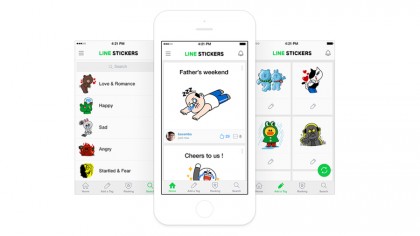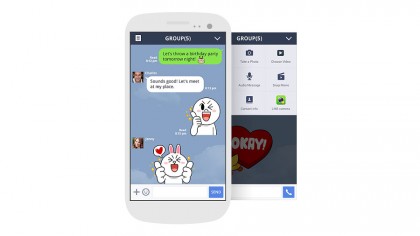Meet the WhatsApp rival that makes millions selling stickers
The biggest social networking website you've never heard of

Our meeting with Line, a growing mobile instant messaging application very popular in Asia, was arranged in a nondescript room in Barcelona, a couple of weeks ago at MWC, but the company I was meeting was anything but unambitious.
Line is a subsidiary of South Korean internet behemoth, Naver, but its importance is such that it managed to become the company's main revenue source within just a few years.
Despite having "only" 181 million monthly active users (MAU), the company's Head of Business for the EU remains adamant that the firm will be able to catch up to its bigger rivals, Chinese WeChat (488m MAU) and US-based WhatsApp (around 700m MAU).
Sunny YoungEun Kim told us that Line has used Spain as the test bed for its onslaught on the European market. Spain has the lion's share of the 30 million active users in Europe with about 18 million MAU, and the service has yet to make any significant gains in the two biggest European markets, UK and Germany.
"They're still fresh for picking," Kim quipped.
What it does offer though is an intriguing insight into how instant messaging services might evolve as the race to diversify revenue sources becomes more frantic.
Money spinner
A little known fact about Line is that it is the world's biggest revenue generator on Apple's iOS and Google's Android platforms outside of games.
Sign up to the TechRadar Pro newsletter to get all the top news, opinion, features and guidance your business needs to succeed!
It generated a staggering 611 million Euros (about £436 million, $645 million, AU$843 million) in revenue in its last financial year. And that has been achieved without any advertising.
In comparison, WhatsApp brought in a paltry $16 million (about £11 million, AU$21 million, 15 million Euros) in the first half of last year, which normalised for a whole year is about one-twentieth of what Line has achieved.
The difference on an ARPU (Average Revenue Per User) basis is even more jaw-dropping. Each Line user brought in on average $3.56 per year, compared to $0.02 for Facebook's big acquisition.
No wonder that Naver is said to be preparing for an IPO for Line after having grown its international user base. The South Korean company has managed to crack the revenue problem which allows it to then focus on organically growing its user base.

Games and stickers
Line derives just over half of its revenue from labelled Line games (such as Line Raiders) with nearly a third coming from – wait for it – stickers, and the rest from its B2B activities.
The company has more than 100 different games that are connected to Line, with a Line app marketplace hosting the lot as well as a number of other consumer-focused efforts such as Line Pay or Line Taxi, an Asian rival to Uber.
Stickers are a surprising addition to anyone's bottom line, let alone an online one. The company has managed to carve itself a sizeable niche allowing its users to create stickers easily as well as buying and selling them.
B2B aspects
Line's B2B business is mostly centred on the creation of "official" accounts. Manchester United and Chelsea for example have their own official Line accounts but other businesses have to fork out fees for their official ones with the added benefit of a B2B API.
The main focus, Kim told me, was on the SMB market and small business owners.
With such a well-established revenue model, it's not surprising that Kim appears uncannily cool about the competition. Yes, WhatsApp is bigger and more established, but "they have a subscription model" she added, one that users need to pay for after using it for a year.
Line, she says, will never introduce a subscription; nor will it use advertising, content marketing or native content to prop up its bottom line.
Still, breaking the user base conundrum outside Korea and Japan appears to be the company's biggest challenge yet. "We had the first user advantage in the Asian market, which gave us a concrete identity," Kim conceded.

What will happen down the Line?
Matters are slightly different in Europe where things are more localised. What does the future entail for Line?
They are already testing a free call service that allows video calls as well, not unlike Skype. Like the latter you will be able to pay a premium to call fixed lines. It's already being tested in Spain and is available in Asia.
Line Connect is also another potential growth avenue for the company as it tries to establish a service that allows customers to get in touch with businesses via their official Line accounts.
Surprisingly, Kim also revealed that Line Chat will come to the PC as an old-style application rather than stuck in the browser as a plug-in.
"That's part of a bigger plan," she said, one aimed at providing "a lot of services" including entertainment, radio and media. It's not about technical innovation, she added, but more about delivering a better user experience.
What about specific plans for the UK? With two of the country's biggest football teams already on board, Kim said that the company had ambitious targets which would not only involve developers but also local designers.

Désiré has been musing and writing about technology during a career spanning four decades. He dabbled in website builders and web hosting when DHTML and frames were in vogue and started narrating about the impact of technology on society just before the start of the Y2K hysteria at the turn of the last millennium.